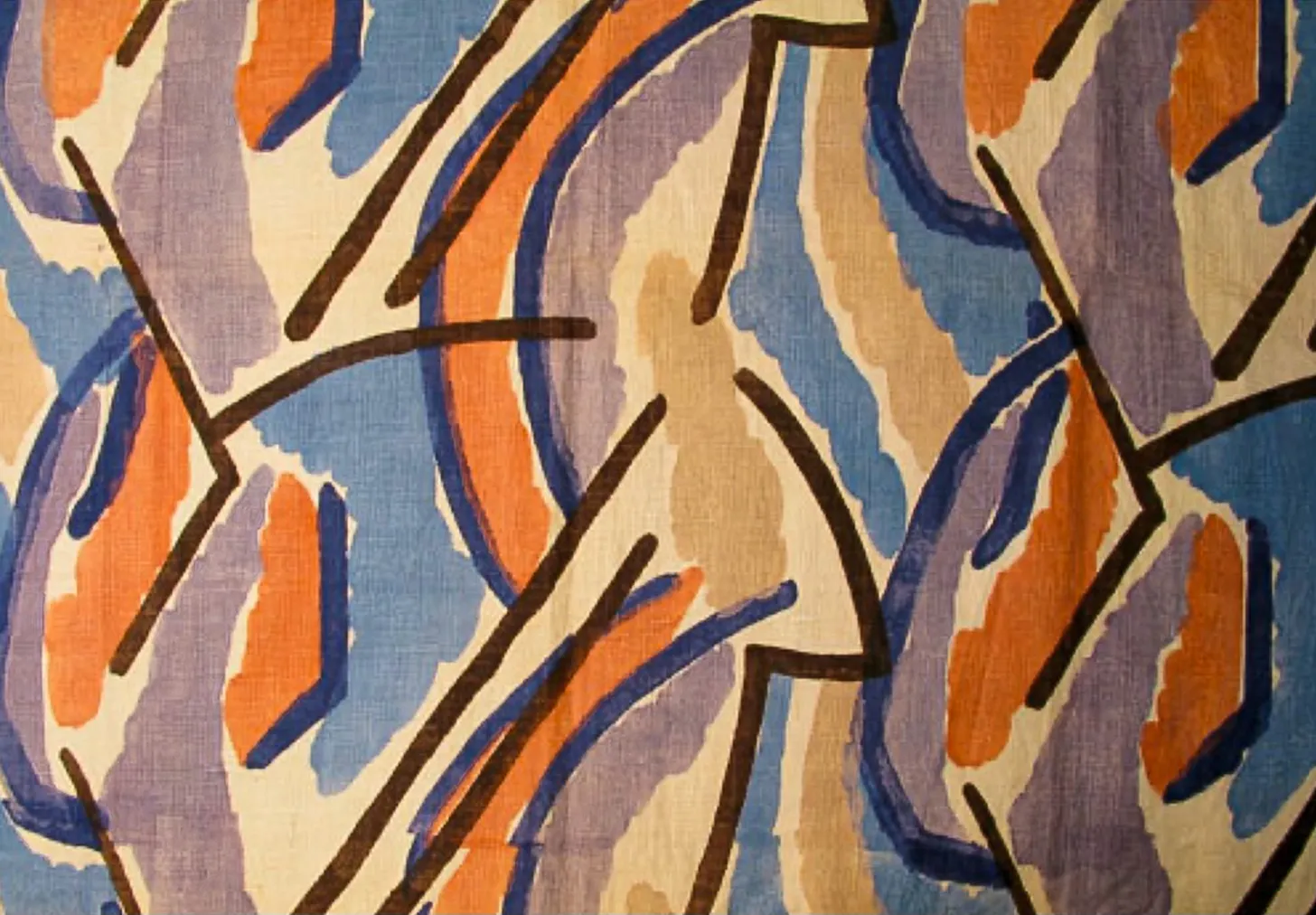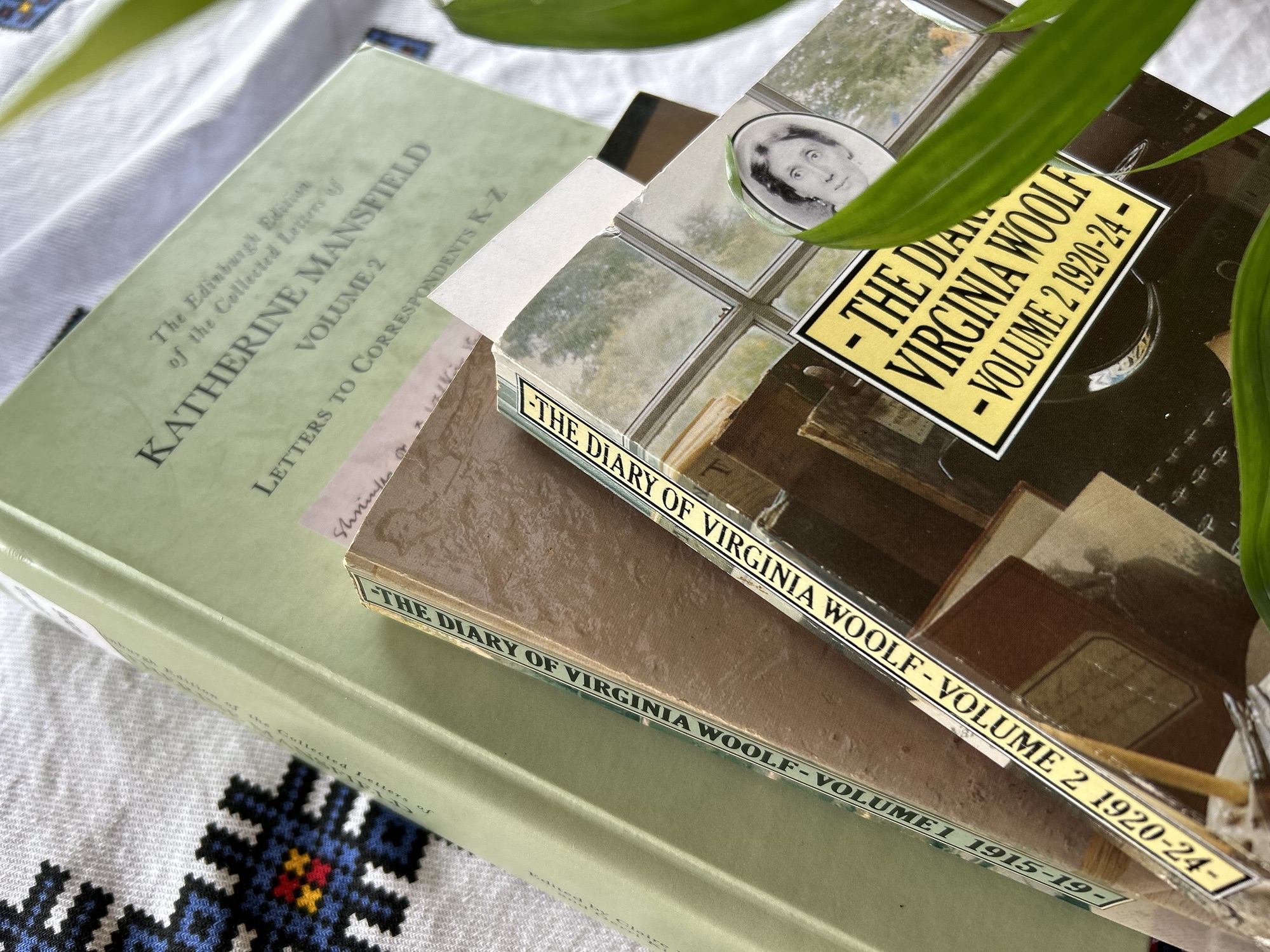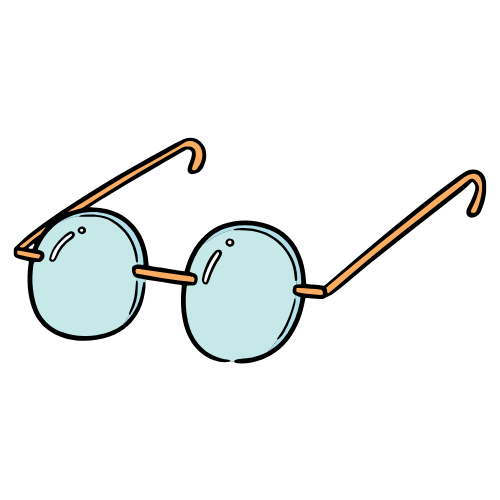In ‘Je ne parle pas francais’ Katherine Mansfield writes, among many things, of a would-be writer who haunts the cafes of Paris in search of material for his writing, a predator who uses moments of life to build his fictional world. I think I never really grasped the horrendous selfishness of this act as I did while going through the diaries and letters of Virginia Woolf and Katherine Mansfield for this blog post. What I wanted was to build a statue of their friendship based on their readings of each other’s work. I have Woolf’s own words of “KM” and “Katherine” which give me what I need to build my statue. I have Mansfield’s letters to Woolf bunched together in a new edition edited by Claire Davison and Gerri Kimber. But now I’m not so sure I can cut out Woolf of Mansfield’s life and Mansfield of Woolf’s life and shape a concrete statue out of words stolen from the flow of a day.
This is the fourth and final blog post of a mini-series centered on Katherine Mansfield’s short stories and what makes them so special. Some weeks ago, I wrote on some general characteristics of Mansfield’s fiction. Then, my literary friend Gertrude mused on the lasting impressions Mansfield left on her and I wrote on the dark side of Mansfield’s short stories. In this final blog post I will let Katherine, the person, speak for herself, as she does in the letters she wrote to her friend and competitor, Virginia Woolf. The final lecture of the Literature Cambridge course which prompted this mini-series was live this week.
the same passion for writing
When Virginia Woolf and Katherine Mansfield met, is a matter of where you get your information from. Some sources say they met at the end of 1916, others say at the beginning of 1917. Some say the two writers were introduced by Lytton Strachey, others say by Mansfield’s Ukrainian friend, Samuel Koteliansky. We’ll probably never know for sure and, to be honest, it probably doesn’t even matter so much. What matters is that Katherine met Virginia, and over the next 6 years, until Katherine’s death in 1923, they had a tumultuous relationship, marked by appraisal and appreciation, but also by sharp critique and cold shoulders.
By the summer of 1917 Katherine Mansfield and Virginia Woolf were acquainted enough with each other to be paying each other visits. Katherine was in awe of Virginia and her “passion for writing” and said it in so many words in a letter written that summer. They were planning a visit for dinner. The Woolfs’ Hogarth Press was already up and running and Virginia was looking for an author to publish. By the 25th of July, the date of her next letter, Katherine’s ‘Prelude’ had been accepted for publication.
The memory of the last evening is so curious… a feeling that outside the window floated a deep dark stream full of a silent rushing of little eels with pointed ears going to Norway and back… Pray consider how rare it is to find someone with the same passion for writing that you have, who desires to be scrupulously truthful with you – and to give you the freedom of the city without any reserves at all [21 June 1917]
‘kew gardens’ and ‘prelude’
In parallel with Mansfield working on ‘Prelude’, a revisited version of her earlier ‘The Aloe’, Woolf was perfecting her own form of experimental writing. The short stories ‘The Mark on the Wall’, ‘Kew Gardens’ and ‘An Unwritten Novel’ would mark her departure from the more traditionally styled The Voyage Out to Jacob’s Room, her first really Modernist novel published in 1922.
In her letters of August 1917 Katherine writes Virginia that she wants to talk to her about her ‘Mark on the Wall’ and that “your Flower Bed is very good”, referring to the main element of ‘Kew Gardens’.
It was good to have time to talk to you: we have got the same job, Virginia & it is really very curious & thrilling that we should both, quite apart from each other, be after so very nearly the same thing… Yes your Flower Bed is very good. There’s a still, quivering, changing light over it all and a sense of those couples dissolving in the bright air which fascinates me [23 August 1917]
The letter exchange continued through 1918, though we are rather “blind” regarding Virginia’s letters. Katherine barely kept any, or barely any were found. We only know what she writes herself.
Yes, I am very sorry that we shall not see each other this week. Your Pearl of a Letter made me realise what an infinite deal I want to talk about with you [23 July 1918]
Your brilliant brilliant letter – was so captivating that Murry suggests we frame it in a revolving frame to be a joy for ever more. [27 November 1918]
How fond Virginia was of Katherine’s company and the secret bond which seemed to have grown between them we can read in Virginia’s diary. Virginia feels she can peer beyond her friend’s outside composure and reach her innermost self because of their common love of writing.
Katherine was marmoreal, as usual. She looks ghastly ill. As usual we came to an oddly complete understanding. My theory is that I get down to what is true rock in her, through the numerous vapours & pores which sicken or bewilder most of our friends. It’s her love of writing I think [28th May 1918]
‘bliss’ and night and day
Less than three months later, though, Virginia feelings about the rock in Katherine shift. She had read ‘Bliss’ and was not impressed. It’s not clear for me though, if she can be so wrong in her criticism of her friend’s work or if she let a personal feeling of jealousy, maybe, cloud her very sound literary judgement. Even more so, on the 9th of November she notes, of ‘Je ne parle pas francais’, assumingly, that “The long story she has written breathes nothing but hate”
I threw down Bliss with the exclamation “She’s done for!” Indeed I don’t see how much faith in her as a woman or writer can survive that sort of story. I shall have to accept the fact, I’m afraid, that her mind is a very thin soil, laid an inch or two deep upon very barren rock… She writes badly too. And the effect was as I say to give me an impression of her callousness & hardness as a human being… Or is it absurd to read all this criticism of her personally into a story? [7th August 1918]
In the autumn and winter of 1918 Mansfield was in London, but her letters to Virginia are quite short, if containing appreciative words for their friendship. In her August/September/November letters she mentions her health state worsening (due to her tuberculosis) and her regret for having to cancel visits and sending only short replies to letters. The next long later is dated 11th April 1919.
Virginia visited several times during that winter, but her feelings towards Katherine are ambivalent. She doesn’t feel the emotional response which Katherine had written about in her short letters.
Upstairs I have letters in which she speaks of finding the thought of me a joy, dwelling upon my writing with excitement; I have letters making appointments, pressing for visits, adding postscripts of thanks & affection to visits already paid. The question interests, amuses, & also slightly, no, very, decidedly, pains me… The truth is, I suppose, that one of the conditions unexpressed but understood of our friendship has been precisely that it was almost entirely founded on quicksands [18th February 1919]
Their relationship rekindled over the spring and summer of 1919 (“a durable foundation” wrote Virginia in her diary in July), but the next blow came in the autumn of 1919. Katherine moved to the French town of Menton, as it had a more forgiving climate for her tuberculosis. Even though their correspondence of the summer was warm and intimate, Katherine’s letters suddenly stopped. The next thing Virginia knew was Katherine’s stingy review of Night and Day, her not-yet-Modernist novel published in the autumn of 1919.
We had thought that this world was vanished for ever, that it was impossible to find on the great ocean of literature a ship that was unaware of what has been happening. Yet here is ‘Night and Day’ fresh, new, and exquisite, a novel in the tradition of the English novel [review published on the 21st November 1919]
Woolf did not appreciate this at all. The two writers were supposed to seek an experimental form of literature together and look how Katherine has no interest in novels, as Woolf reported to Murry. Maybe Mansfield felt betrayed as well, by what she perceived to be a traditional English novel written by someone as Woolf, who had penned ‘Kew Gardens’.
one lives by the sky again
There were no letters on any part, until May 1920, when Katherine returned to England and Virginia paid her a visit, in response to her “stiff & formal note”. During the visit the months they haven’t seen each other melted away and the two “fell into step” again.
No pleasure or excitement at seeing me. And then we talked about solitude, & I found her expressing my feelings, as I never heard them expressed… I feel a common certain understanding between us – a queer sense of being ‘like’ – not only about literature – & I think it’s independent of gratified vanity. I can talk straight out to her. [31st May 1920]
In July and August 1920 Katherine wrote two more letters. In July the two friends had seen a performance of Chekhov’s The Cherry Orchard, which Katherine had felt “frightened” and “terrified” of. Too many emotions piled up and too many “strange human beings”.
In September Katherine left for Menton again, and Virginia and her met for the last time in August. Katherine asked Virginia to review her volume Bliss and Other Stories, but Virginia never did, even though she intended to. She doesn’t know either if Katherine’s request was honest. “Strange how little we know our friends”, she writes.
After noting my own callousness, of a sudden comes the blankness of not having her to talk to. A woman caring as I care for writing is rare enough I suppose to give me the queerest sense of echo coming back to me from her mind the second after I’ve spoken… I said how my own character seemed to cut out a shape like a shadow in front of me. This she understood [25th August 1920]
In December Katherine wrote the last letter she ever sent to Virginia. There is a sense of deep affection she pours out on the page and hunger for life. She writes of the little house in Menton and the sun and the wild orchids. I almost feel like dropping everything and putting on my headset with a Beethoven sonata and lying down in the green green grass of May. What else is there?
You are the only woman with whom I long to talk work. There will never be another. But leagues divide us. I have taken this little house until the end of 1922. Perhaps you will come here before then. It is in the country & there is a garden & a stone terrace. It is solitary but not lonely. One lives by the sky again – by the changes of cloud & light [27 December 1920]
that strange ghost
And then Katherine died, in January 1923. She had published The Garden Party and Other Stories at the end of 1922, but Virginia was already too embittered to appreciate it. There had been no letter exchange since that end of December 1920. A letter Virginia wrote early 1921 was left unanswered.
An entry in Virginia’s diary from October 1924, more than a year after Katherine passed, hints at the fact that Virginia never let go of her friend, and an even more subtle relationship between the two started. Katherine’s ghost would return over the years to Virginia’s thought and memory and her mark would continue to influence Woolf, the writer, who never again wrote a “traditional English novel”.
The thought of Katherine Mansfield comes to me – as usual rather reprehensibly – first wishing she could see Southhampton Row, thinking of the dullness of her death, lying there at Fontainebleau – an end where there was no end… I think of her in this way off & on – that strange ghost, with the eyes far apart, & the drawn mouth, ragging herself across the room… K & I had our relationship; & never again shall I have one like it [17 October 1924]
Reading through Katherine Mansfield and Virginia Woolf’s letters I got the sense of a person gulping down life like water, always thirsty, always wanting more. Katherine loves Virginia deeply and writes to her about her days, her pains and her books. Virginia, on the other hand, was caught between “an oddly complete understanding” and contempt for Mansfield’s “bad” writing. But Katherine had dozens of correspondents and Woolf writes of dinner parties, visits of friends and technical details of her Hogarth Press. Their feelings are coloured by their days, but also by misunderstandings and a lack of appreciation for what the other one is going through. Katherine died before all this could be settled. Can I do better with my friends?





your thoughts?